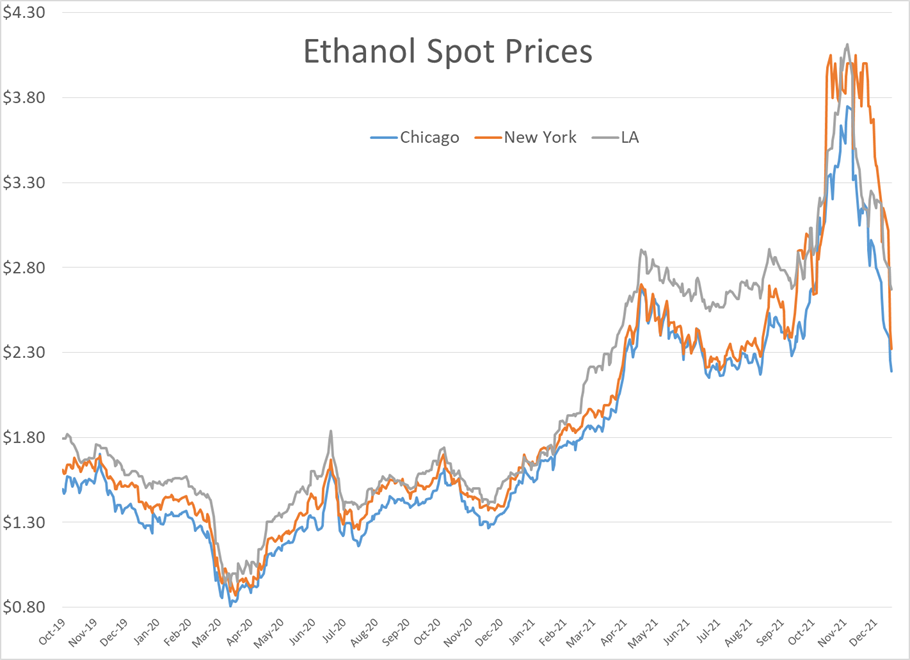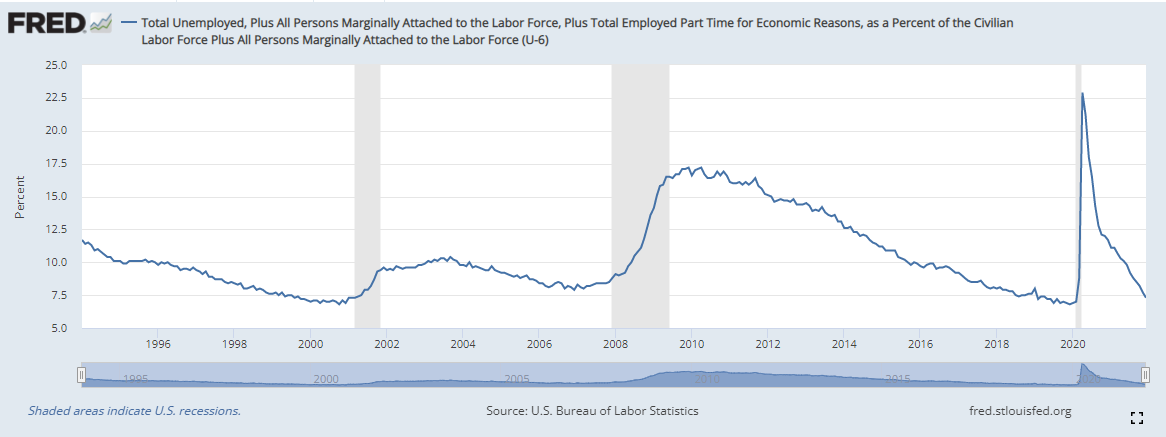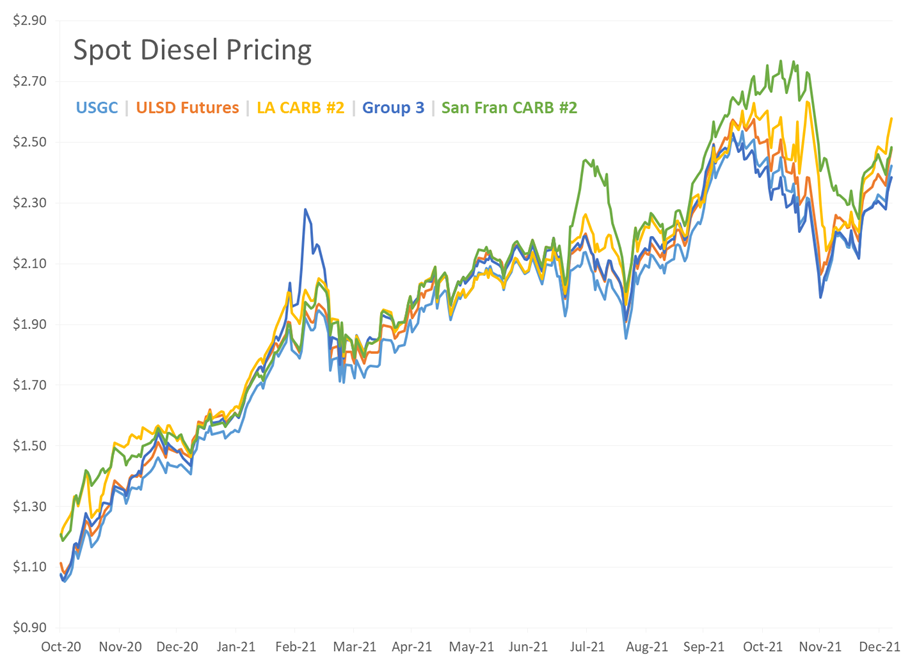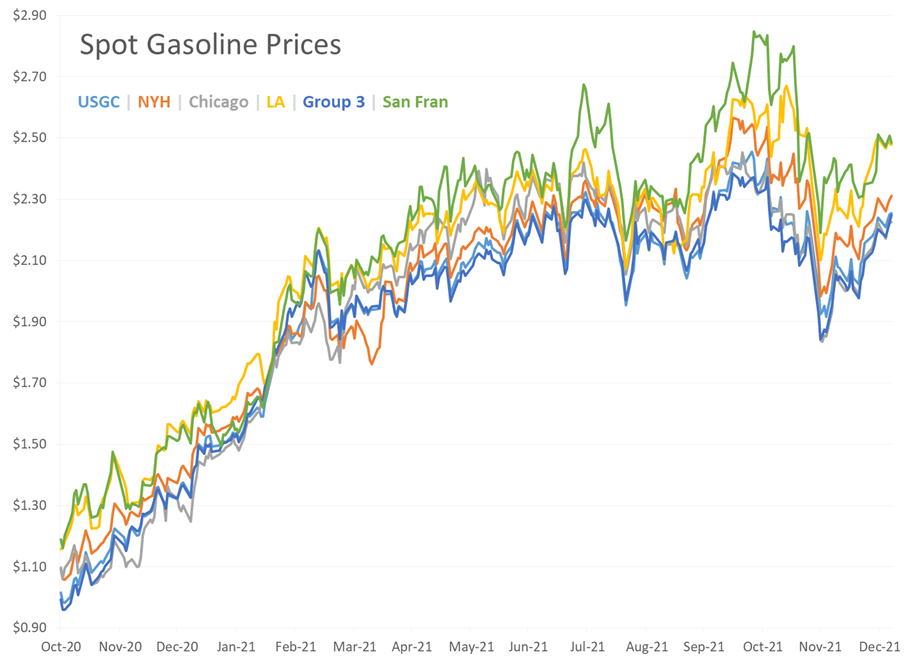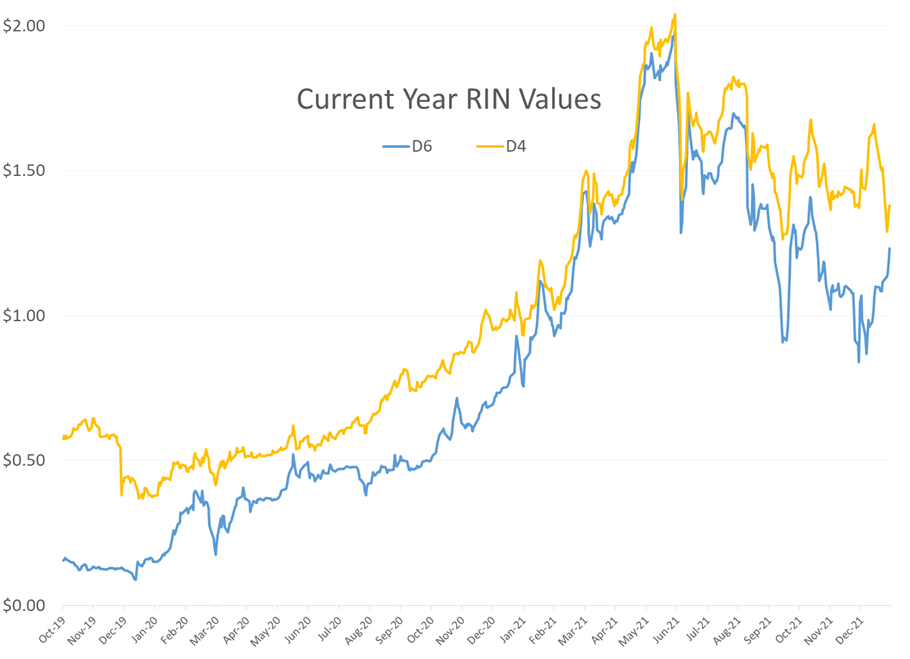Petroleum Futures Are Working To Go 5 For 5 To Start The New Year As The Bull Run Continues

Petroleum futures are working to go 5 for 5 to start the new year as the bull run continues, pushing ULSD back to the $2.50 mark and WTI above $80 in early trading. Cash prices haven’t seen as dramatic a move as futures in most cases as they had to overcome the New Year’s Eve futures selloff that didn’t hit wholesale prices until Monday night, but are still pointing towards healthy gains, despite evidence that we’re experiencing the worst fuel demand in parts of the country since the 2020 lockdowns as a parade of winter storms has accentuated the typical seasonal slowdown.
While there’s no doubt the bulls took control of the energy markets this week, now that the short term technical targets have been reached, it looks like we could be due for a period of sideways trading, especially if we lose upward momentum in equity markets. Longer term, the bulls will need to find a way to make a run at the October highs in the next month or two – which is easier said than done this time of year – if they’re to avoid a longer-term bearish pattern on the charts.
The December Jobs report showed another healthy month of increases with 199,000 jobs created, while both the headline and “real” (U-6) unemployment rates continued their declines. In addition, the October and November estimates were revised higher by 149,000 jobs, adding to the overall feeling of strength in the labor market. Energy prices haven’t reacted much to the report, but equity prices are coming under pressure and interest rates are pushing higher again as we remain in a “good news is bad news” market since the strong job market just gives the FED another reason to shut down the money printing presses and start raising rates.
Back in the USSR: Russian troops have invaded intervened to quell deadly protests in Kazakhstan over the removal of fuel price subsidies. Those protests appear to also be interrupting crude exports from the country’s largest oilfield, which – combined with ongoing disruptions in Libyan - is likely to keep actual production from the OPEC & Friends cartel well below their target levels.
RIN prices have continued their steady march higher this week, and D6 (ethanol) values are now threatening the downward sloping trend-line that pushed prices from $2 in June to 80 cents in December. There doesn’t appear to be any “new” news driving the run-up in RINs, but the ongoing industry statements regarding the EPA’s proposed rules for 2020-2022 suggest that if those RVO’s become law, we’re destined to see another extended court battle.
Ethanol prices meanwhile continue to see a dramatic drop, with most US spot markets now trading $1.50/gallon or more lower than they were just 6 weeks ago the winter demand doldrums that are being felt by gasoline producers all over the country are spilling over into the alcohol fuel arena and helping alleviate the supply bottlenecks that drove the record setting backwardation last year.
Today’s interesting read: Climate Change mistakes and the influence of fuel prices in politics.
Click here to download a PDF of today's TACenergy Market Talk.
Latest Posts
Energy Markets Rally Again Thursday After A Choppy Wednesday Session
Week 16 - US DOE Inventory Recap
Energy Markets Trading Quietly In The Red As Ethanol Prices Rally To Five-Month High
The Struggle For Renewable Producers Continues As A Rapid Influx Of Supply And Crashing Credit Prices Make Biodiesel
Social Media
News & Views
View All
Energy Markets Rally Again Thursday After A Choppy Wednesday Session
Energy markets are trying to rally again Thursday after a choppy Wednesday session. RBOB gasoline futures are leading the push higher, on pace for a 3rd consecutive day of gains after finding a temporary floor Tuesday and have added 12 cents from those lows.
Equity markets are pointing sharply lower after a weak Q1 GDP estimate which seems to have contributed to a pullback in product prices over the past few minutes, but don’t be surprised if the “bad news is good news” low interest rate junkies start jumping in later on.
The DOE’s weekly report showed sluggish demand for gasoline and diesel, but inventory levels in most markets continue to follow their typical seasonal trends. Refinery runs held fairly steady last week with crude inputs down slightly but total gross throughputs up slightly as most facilities are now back online from a busy spring maintenance season and geared up for peak demand this summer.
Propane and propylene exports spiked to a record high north of 2.3 million barrels/day last week, which demonstrates both the US’s growing influence on global product markets, and the steady shift towards “other” products besides traditional gasoline and diesel in the level of importance for refiners.
The EIA acknowledged this morning that its weak diesel consumption estimates reflected the switch to Renewable Diesel on the West Coast, although they did not provide any timeline for when that data will be included in the weekly survey. The agency acknowledged that more than 4% of the total US consumption is now a combination of RD and Biodiesel, and that number is expected to continue to grow this year. This morning’s note also suggested that weak manufacturing activity was to blame for the sluggish diesel demand across the US, while other reports suggest the freight recession continued through Q1 of this year, which is also contributing to the big shift from tight diesel markets to oversupplied in several regions.
Valero kicked off the Q1 earnings releases for refiners with solid net income of $1.2 billion that’s a far cry from the spectacular earnings north of $3 billion in the first quarter of 2023. The refining sector made $1.7 billion, down from $4.1 billion last year. That is a pattern that should be expected from other refiners as well as the industry returns to a more normal market after 2 unbelievable years. You wouldn’t guess it by looking at stock prices for refiners though, as they continue to trade near record highs despite the more modest earnings.
Another pattern we’re likely to see continue with other refiners is that Renewable earnings were down, despite a big increase in production as lower subsidies like RINs and LCFS credit values sting producers that rely on those to compete with traditional products. Valero’s SAF conversion project at its Diamond Green joint venture is progressing ahead of schedule and will give the company optionality to flip between RD and SAF depending on how the economics of those two products shakes out this year. Valero also shows part of why refiners continue to disappear in California, with operating expenses for its West Coast segment nearly 2X that of the other regions it operates in.

Week 16 - US DOE Inventory Recap

Energy Markets Trading Quietly In The Red As Ethanol Prices Rally To Five-Month High
Energy markets are trading quietly in the red to start Wednesday’s session after a healthy bounce Tuesday afternoon suggested the Israel-Iran-linked liquidation had finally run its course.
There are reports of more Ukrainian strikes on Russian energy assets overnight, but the sources are sketchy so far, and the market doesn’t seem to be reacting as if this is legitimate news.
Ethanol prices have rallied to a 5-month high this week as corn and other grain prices have rallied after the latest crop progress update highlighted risks to farmers this year, lower grain export expectations from Ukraine, and the approval of E15 blends this summer despite the fact it pollutes more. The rally in grain and renewables prices has also helped RIN values find a bid after it looked like they were about to test their 4-year lows last week.
The API reported small changes in refined product inventories last week, with gasoline stocks down about 600,000, while distillates were up 724,000. Crude oil inventories increased by 3.2 million barrels according to the industry-group estimates. The DOE’s weekly report is due out at its normal time this morning.
Total reported another upset at its Port Arthur refinery that’s been a frequent flier on the TCEQ alerts since the January deep freeze knocked it offline and damaged multiple operating units. This latest upset seems minor as the un-named unit impacted was returned to normal operations in under an hour. Gulf Coast basis markets have shrugged off most reports of refinery upsets this year as the region remains well supplied, and it’s unlikely we’ll see any impact from this news.
California conversely reacted in a big way to reports of an upset at Chevron’s El Segundo refinery outside of LA, with CARBOB basis values jumping by more than a dime. Energy News Today continued to show its value by reporting the upset before the flaring notice was even reported to area regulators, proving once again it’s ahead of the curve on refinery-related events. Another industry news outlet meanwhile struggled just to remember where the country’s largest diesel seller is located.
Click here to download a PDF of today's TACenergy Market Talk
